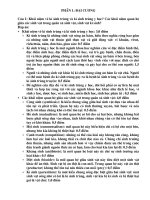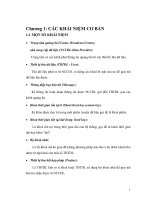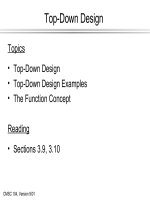Tài liệu Ancient Civilizations Biographies pptx
Bạn đang xem bản rút gọn của tài liệu. Xem và tải ngay bản đầy đủ của tài liệu tại đây (1.69 MB, 239 trang )
Biographies
Ancient
Civilizations
AC-Bio.tpgs 10/28/99 2:34 PM Page 1
Biographies
Judson Knight
Stacy A. McConnell and
Lawrence W. Baker, Editors
Ancient
Civilizations
AC-Bio.tpgs 10/28/99 2:34 PM Page 3
Judson Knight
Staff
Stacy A. McConnell, Lawrence W. Baker, U•X•L Editors
Carol DeKane Nagel, U•X•L Managing Editor
Tom Romig, U•X•L Publisher
Rita Wimberley, Senior Buyer
Evi Seoud, Assistant Production Manager
Mary Beth Trimper, Composition Manager
Margaret A. Chamberlain, Permissions Specialist (pictures)
Martha Schiebold and Michelle DiMercurio, Senior Cover Art Directors
Pamela A.E. Galbreath, Senior Page Art Director
Cynthia Baldwin, Product Design Manager
Barbara J. Yarrow, Graphic Services Supervisor
Linda Mahoney, LM Design, Typesetting
Front cover: Cleopatra, drawing. Archive Photos. Reproduced by permission.
Back cover: Confucius, drawing. Library of Congress.
Library of Congress Cataloging-in-Publication Data
Knight, Judson
Ancient Civilizations: Biographies / Judson Knight; edited by
Stacy A. McConnell and Lawrence W. Baker
p. cm.
Includes biographical references and index
ISBN 0-7876-3985-0
Civilization, Ancient–Juvenile literature. 2. Biography–To
500–Juvenile literature.
[1. Civilization, Ancient–Biography.] I. McConnell, Stacy A. II.
Title
CB311 .K595 2000
930–dc21 99-045751
[B]—DC21 99-20707
CIP
This publication is a creative work copyrighted by U•X•L and fully pro-
tected by all applicable copyright laws, as well as by misappropriation,
trade secret, unfair competition, and other applicable laws. The authors
and editors of this work have added value to the underlying factual mate-
rial herein through one or more of the following: unique and original
selection, coordination, expression, arrangement, and classification of the
information. All rights to this publication will be vigorously defended.
Copyright © 2000 U•X•L, An Imprint of The Gale Group
All rights reserved, including the right of reproduction in whole or in part
in any form.
Printed in the United States of America
10 9 8 7 6 5 4 3 2 1
Ancient Civilizations: Biographies
ACbFM.qxp 11/5/1999 1:09 PM Page iv
v
To Tyler, from her ancient daddy;
and to Deidre, from her modern husband.
ACbFM.qxp 11/5/1999 1:09 PM Page v
Advisory Board ix
Reader’s Guide xi
Words to Know xiii
Timeline xix
Biographies
Akhenaton 1
Alexander the Great 8
Aristotle 15
Asoka 24
Marcus Aurelius 30
Boadicea 38
Buddha 45
Julius Caesar 52
Cleopatra 60
Confucius 68
Constantine 76
vii
Contents
Akhenaton attempted to
completely reshape
Egyptian religion.
(Reproduced by permission.
Corbis-Bettmann.)
ACbFM.qxp 11/5/1999 1:09 PM Page vii
David 83
Hannibal 90
Hatshepsut 97
Herodotus 104
Imhotep 111
Jesus Christ 117
Moses 123
Nebuchadnezzar II 131
Paul 138
Pericles 144
Piankhi 151
Plato 157
Sargon of Akkad 164
Scientists and Mathematicians 169
Sculptors 177
Ch’in Shih Huang Ti 183
Vergil 189
Wu Ti 196
Xerxes 202
Index xxxix
viii Ancient Civilizations: Biographies
ACbFM.qxp 11/5/1999 1:09 PM Page viii
S
pecial thanks are due to U•X•L’s Ancient Civilizations Ref-
erence Library advisors for their invaluable comments and
suggestions:
• Jonathan Betz-Zall, Children’s Librarian, Sno-Isle Regional
Library, Edmonds, Washington
• Nancy Guidry, Young Adult Librarian, Santa Monica Pub-
lic Library, Santa Monica, California
• Karen Shugrue, Junior High Media Specialist, Agawam
Junior High School, Feeding Hills, Massachusetts.
ix
Advisory Board
ACbFM.qxp 11/5/1999 1:09 PM Page ix
A
ncient Civilizations: Biographies presents the life stories of
thirty-eight individuals who had a great influence on the
ancient civilization in which they lived. The biographies span
from the beginning of Sumerian civilization in 3500 B.C. to
the decline of the Teotihuacán around A.D. 750. Well-known
historical figures, such as Greek philosopher Aristotle and Per-
sian emperor Xerxes, are featured, as well as lesser-known fig-
ures, such as Celtic queen Boadicea and Egyptian ruler Hat-
shepsut. More than 50 black-and-white illustrations and
photographs enliven the text, while cross references provide
easy access to related figures. Sidebars in every entry focus on
high-interest topics, and a “For More Information” section
guides the researcher to other reference sources. Ancient Civi-
lizations: Biographies also features a glossary of terms used
throughout the volumes, a timeline containing significant
milestones within the lives of the individuals profiled, and an
index covering the people, places, and events discussed
throughout Ancient Civilizations: Biographies.
xi
Reader’s Guide
ACbFM.qxp 11/5/1999 1:09 PM Page xi
Comments and Suggestions
We welcome your comments on Ancient Civilizations:
Biographies, as well as your suggestions for persons to be fea-
tured in future editions. Please write, Editors, Ancient Civiliza-
tions: Biographies, U•X•L, 27500 Drake Rd., Farmington Hills,
Michigan, 48331-3535; call toll-free: 1-800-877-4253; fax to
(248) 699-8097; or send e-mail via-.
xii Ancient Civilizations: Biographies
ACbFM.qxp 11/5/1999 1:09 PM Page xii
A
Acropolis: An elevated fortress in Greek cities.
Ancestor: An earlier person in one’s line of parentage, usually
more distant in time than a grandparent.
Anoint: To pour oil over someone’s head as a symbol that God
has chosen that person to fill a position of leadership.
Apostle: A religious figure who is sent out to teach, preach,
and perform miracles.
Archaeology: The scientific study of past civilizations.
Architect: Someone who designs a building or other structure.
Aristocrat: A very wealthy and/or powerful person.
Assassination: Killing, usually of an important leader, for
political reasons.
B
Baptism: To be lowered into water as a symbol of death and
rebirth.
xiii
Words to Know
ACbFM.qxp 11/5/1999 1:09 PM Page xiii
Bureaucracy: A network of officials who run a government.
Bust: A sculpture of a human head, neck, and shoulders.
C
Caravan: A company of travelers, usually with pack animals,
through a desert or other forbidding region.
Caste system: A system of ranking people into very social
groups, which prevailed in India from ancient times to
the modern day.
Census: A count of the people living in a country.
Civil servant: Someone who works for the government.
Civil war: A military conflict that occurs when a group of cit-
izens within a nation attempts to break away from the
rule of the government.
Commoner: Someone who is not a member of a royal or noble
class.
Concubine: A woman whose role toward a man is like that of
a wife, but without the social and legal status of a wife.
Constitution: A set of written laws governing a nation.
Contemporary (n.): Someone who lives at the same time as
another person.
Cremation: The burning, as opposed to burial, of a dead body.
Crucifixion: A Roman punishment in which the victim was
nailed up to a cross until he died.
Cult: A small religious group, most often with highly unusual
beliefs.
D
Deify: To turn someone or something into a god.
Deity: A god.
Democracy: A form of government in which the people, usu-
ally through elected representatives, rule.
Descendant: Someone who is related to an earlier person, or
ancestor.
Disciple: A close follower of a religious teacher.
xiv Ancient Civilizations: Biographies
ACbFM.qxp 11/5/1999 1:09 PM Page xiv
E
Edict: A command.
Epic: A long poem that recounts the adventures of a legendary
hero.
Epistle: A letter.
Eunuch: A man who has been castrated, thus making him
incapable of sex or sexual desire.
F
Famine: A period when there is not enough food in a region
to feed all its people.
Fasting: Deliberately going without food, often but not always
for religious reasons.
G
Gentile: Someone who is not a Jew.
H
Hellenic: Greek.
Hellenistic: Influenced by Greece.
Heresy: Something that goes against established religious doc-
trine.
Hoplite: A heavily armed foot soldier.
I
Islam: A faith that arose in Arabia in the 600s A.D., led by the
prophet Muhammad (A.D. 570?–632.)
L
Legacy: Something that is left to a later generation.
Legitimacy: The right of a ruler to hold power.
xvWords to Know
ACbFM.qxp 11/5/1999 1:09 PM Page xv
M
Martyr: Somebody who dies for their faith.
Medieval: Relating to the Middle Ages.
Mercenary: A professional soldier who will fight for whoever
pays him.
Middle Ages: The period from the fall of the Roman Empire
to the beginning of the Renaissance, roughly 500 to
1500
A.D.
Middle Class: A group in between the rich and the poor, or the
rich and the working class.
Millennium: A period of a thousand years.
Mint (v.): To produce currency.
Missionary: Someone who goes to other lands to convert oth-
ers to their religion.
Moat: A trench, filled with water, which surrounds a castle or
city.
Monarch: A king.
Monotheism: Belief in one god.
Muslim: A believer in Islam.
N
Noble: A ruler within a kingdom who has an inherited title
and lands, but who is less powerful than the king or
queen.
O
Obelisk: A tall, free-standing column of stone.
Oligarchy: A government ruled by a few people.
P
Pagan: Someone who worships many gods; also used as an
adjective.
Papyrus: A type of reed from which the Egyptians made the
first type of “paper.”
xvi Ancient Civilizations: Biographies
ACbFM.qxp 11/5/1999 1:09 PM Page xvi
Peasant: A farmer who works a small plot of land.
Phalanx: A column of hoplites designed for offensive warfare.
Pharisee: A member of a group of Jewish religious scholars
who demanded strict adherence to religious law.
Philosophy: A discipline which seeks to reach a general under-
standing of values and of reality.
Plague: A disease or other disaster that spreads among a group
of people.
Proportion: The size of one thing in relation to something else,
and the proper representation of their relationship.
R
Rabbi: A Jewish teacher or priest.
Radical (adj.): Thorough or sweeping changes in society; used
as an noun for a person who advocates such changes.
Regent: Someone who governs a country when the monarch
is too young, too old, or too sick to lead.
Reincarnation: The idea that people are reborn on earth, and
live and die, again and again.
Relief: In sculpture, a carved picture, distinguished from regu-
lar sculpture because it is two-dimensional.
Renaissance: A period of renewed interest in learning and the
arts which began in Europe in the 1300s and contin-
ued to the 1700s.
Revolution: In politics, an armed uprising against the rulers of
a nation or area.
S
Sack (v.): To destroy a city.
Satrap: A governor in the Persian Empire.
Scribe: A small and very powerful group in ancient society
who knew how to read and write.
Siege: A sustained military attack against a city.
xviiWords to Know
ACbFM.qxp 11/5/1999 1:09 PM Page xvii
xviii Ancient Civilizations: Biographies
Stele (or stela): A large stone pillar, usually inscribed with a
message commemorating a specific event.
Stupa: A dome-shaped Buddhist temple.
T
Theorem: A statement of fact in logic or mathematics, derived
from other formulas or propositions.
Totalitarianism: A political system in which the government
exerts total, or near-total, control.
U
Usurp: To seize power.
Utopia: A perfect society.
V
Vassal: A ruler who is subject to another ruler.
Vineyard: A place where grapes are grown for making wine.
Vizier: A chief minister.
W
West (cap.): The cultures and civilizations influenced by
ancient Greece and Rome.
Z
Ziggurat: A Mesopotamian temple tower.
ACbFM.qxp 11/5/1999 1:09 PM Page xviii
xix
c. 3500 B.C.: Beginnings of Sumerian civilization.
c. 3100 B.C.: Pharaoh Menes unites the kingdoms of Upper
and Lower Egypt.
c. 3000
B.C.: Babylon established.
c. 2920 B.C.: First Dynasty begins in Egypt.
c. 2800
B.C.: Mycenaeans leave the Black Sea area, moving
toward Greece.
2750
B.C
.: Early Dynastic Period begins in Sumer.
c. 2650
B.C.: Beginning of Old Kingdom in Egypt.
c. 2650 B.C.: Step Pyramid of Saqqara, designed by Imhotep,
built under reign of pharaoh Zoser.
c. 2550
B.C.: Great Pyramid of Cheops built in Egypt.
c. 2500
B.C.: Indus Valley civilization begins in India.
c. 2334
B.C.: Sargon of Akkad, first great Mesopotamian ruler
and founder of Akkadian empire, born.
c. 2300
B.C.: Early Dynastic Period ends in Sumer; Akkadian
Empire established.
Timeline
ACbFM.qxp 11/5/1999 1:09 PM Page xix
c. 2200
B.C.: Hsia, semi-legendary first dynasty of China,
begins.
2150
B.C.: End of Old Kingdom in Egypt; beginning of First
Intermediate Period.
c. 2150
B.
C.: Akkadian Empire ends with Gutian invasion of
Mesopotamia; rise of Ur.
c. 2000
B
.C.: Hurrians invade northern Mesopotamia, estab-
lish kingdom of Mitanni.
c. 2000
B.C.: Origins of Gilgamesh Epic in Sumer.
c. 2000
B.C.: Phoenician civilization established.
c. 2000
B.C.: Lung-shan culture develops in northern China.
c. 2000
B.C: Beginnings of Mayan civilization in Mesoamerica.
c. 2000
B.C.: Establishment of Kushite civilization in Africa.
c. 2000
B.C.: Beginnings of Minoan civilization in Crete.
1813
B.C.: Shamshi-Adad, first important Assyrian ruler, takes
throne.
1792
B.C.: End of Old Babylonia in Mesopotamia; Ham-
murabi, who later establishes first legal code in history,
takes throne.
1766
B.C.: Shang Dynasty, first historic line of Chinese kings,
begins.
1759
B.C.: Middle Kingdom ends in Egypt; beginning of Sec-
ond Intermediate Period.
c. 1750
B.C.: Beginning of Hittite civilization, establishment of
capital at Hattush in Asia Minor.
c. 1700
B.C.: Crete experiences earthquake; later the Minoans
rebuild their palaces at Knossos and other sites.
c. 1700–1500
B.C.: Phoenicians develop the world’s first
alphabet.
c. 1650
B.C.: Beginnings of Mycenaean civilization in Greece.
c. 1500
B.C.: Indo-Europeans invade India; beginning of Vedic
Age.
c. 1500
B.C.: Formative or Preclassic Period begins in the
Americas.
xx Ancient Civilizations: Biographies
ACbFM.qxp 11/5/1999 1:09 PM Page xx
c. 1500
B.C.: Thebes founded on Greek mainland.
c. 1500–c. 1300
B.C.: Kingdom of Mitanni flourishes in
Mesopotamia.
1473
B.C.: Pharaoh Hatshepsut assumes sole power in Egypt;
first significant female ruler in history.
c. 1450
B.C.: Minoan civilization in Crete comes to an end,
probably as a result of volcanic eruption on Thera.
1363
B.C.: Ashur-uballit, who establishes the first Assyrian
empire, begins reign.
1352
B.
C.: Pharaoh Amenhotep IV begins his reign in Egypt.
c. 1347: Amenhotep IV changes his name to Akhenaton and
introduces sweeping religious reforms.
1323
B.C.: Death of Tutankhamen in Egypt; power struggle fol-
lows, along with effort to erase memory of Akhenaton.
c. 1300
B.C.: City of San Lorenzo established in Mesoamerica.
1279 B.C.: Beginning of Pharaoh Ramses II’s reign in Egypt.
c. 1200
B.C.: Sea Peoples bring an end to Hittite civilization in
Asia Minor.
c. 1200
B.C.: Aramaeans, after briefly controlling Babylonia,
conquer Syria.
c. 1200
B.C.: Olmec civilization established in what is now
Mexico.
c. 1200
B.C.: Bantu peoples migrate southward from what is
now Nigeria.
c. 1200
B.C.: Trojan War.
c. 1200
B.C.: Etruscans settle on Italian peninsula.
c. 1200–900
B.C.: Carving of giant heads by Olmec in
Mesoamerica.
c. 1140 B.C.: Macedonians move southward, displacing the
Dorians from northern Greece.
c. 1100
B.C.: Dorians bring an end to Mycenaean civilization;
beginning of Dark Ages in Greece, which last for four
centuries.
1070
B.C.: End of New Kingdom in Egypt; Third Intermediate
Period Begins.
Timeline xxi
ACbFM.qxp 11/5/1999 1:09 PM Page xxi
1027
B.C.: Revolt led by Prince Wu Wang brings an end to
Shang Dynasty, and establishment of Chou Dynasty,
in China.
c. 1020
B.C.: Beginning of Saul’s reign in Israel.
c. 1000
B.C.: Saul killed; David becomes ruler of Israel.
c. 1000
B.C.: End of Vedic Age, beginning of Epic Age, in India.
c. 1000
B
.C.: Beginnings of Chavín civilization in South America.
c. 1000
B.
C.: Celts begin to spread from Gaul throughout
Europe.
c. 960
B
.C.: David dies; Solomon becomes ruler of Israel.
922
B.C.: End of Solomon’s reign, and of unified kingdom of
Israel.
800s
B.C.: Dorians establish Sparta.
883
B
.C.: Ashurnasirpal II assumes throne in Assyria, estab-
lishes Neo-Assyrian Empire.
879
B.C.: Beginning of King Ben-Hadad II’s reign in Syria.
c. 850
B.C.: Greeks start trading with other peoples; beginning
of the end of the Dark Ages.
c. 800
B.C.: Carthage established by Phoenicians.
c. 800
B.C.: Poets Homer and Hesiod flourish in Greece.
700s
B.C.: Scythians drive Cimmerians out of the Black Sea
region; Cimmerians spread to Asia Minor and Assyria.
776
B.C.: First Olympic Games held.
771
B.C.: Invasion by nomads from the north forces Chou
Dynasty of China to move capital eastward; end of
Western Chou period.
753
B.C.: Traditional date of Rome’s founding; Romulus first
of seven legendary kings.
c. 751
B.C.: Piankhi takes throne in Kush.
745
B.C.: Tiglath-Pileser III begins reign in Assyria.
722
B.C.: Spring and Autumn Period, a time of widespread
unrest, begins in China.
735
B.C.: Spartans begin twenty-year war with Messenia.
c. 732
B.C.: Assyrians gain control of Syria.
xxii Ancient Civilizations: Biographies
ACbFM.qxp 11/5/1999 1:09 PM Page xxii
c. 725
B.C.: King Mita, probable source of the Midas legend,
unites the Phrygians.
721
B.C.: Sargon II of Assyria conquers Israel and carries off its
people, who become known as the Ten Lost Tribes of
Israel.
715
B.C.: End of war with Messenia brings a rise to Spartan
militarism.
712
B.C.: Kushites under Shabaka invade Egypt, establish
Twenty-Fifth Dynasty.
712
B
.C.: End of Third Intermediate Period, and beginning of
Late Period, in Egypt.
c. 700
B.C.: End of Dark Ages, beginning of two-century
Archaic Age, in Greece.
c. 700
B.C.: City-state of Athens, established centuries before,
dominates Attica region in Greece.
600s
B.C.: State of Magadha develops in eastern India.
600s B.C.: Important developments in Greek architecture:
establishment of Doric order, first structures of stone
rather than wood.
689
B.C
.: Assyrians sack Babylon.
c. 685
B.C.: Gyges founds Mermnad dynasty in Lydia.
672
B.C.: Assyrians first drive Kushites out of Egypt, install
Necho I as pharaoh.
669
B.C
.: Beginning of Ashurbanipal’s reign; last great Assyr-
ian king.
667
B.C.: Assyrian troops under Ashurbanipal complete con-
quest of Egypt from Kushites.
Mid–600s
B.C.: Meröe Period begins when Kushites, removed
from power in Egypt, move their capital southward.
Mid–600s
B.C.: Establishment of Ionian Greek trading colony
at Naucratis in Egypt.
Mid–600s
B.C.: Age of tyrants begins in Greece.
653
B.C.: Scythians overrun Iran.
652
B.C.: Shamash-shuma-ukin, ruler of Babylonia, leads
revolt against his brother Ashurbanipal, king of Assyria.
Timeline xxiii
ACbFM.qxp 11/5/1999 1:09 PM Page xxiii
c. 650
B.C.: Scribes in Egypt develop demotic script.
c. 650
B.C.: Macedonian dynasty begins in northern Greece.
648 B.C.: Ashurbanipal of Assyria subdues Babylonian revolt;
his brother Shamash-shuma-ukin reportedly commits
suicide.
625
B.C.: Thales, first Western philosopher, born in Ionian
Greece.
627
B.C
.: Ashurbanipal of Assyria dies.
625
B.C.: Nabopolassar establishes Chaldean (Neo-Babylon-
ian) Empire.
621
B.C.: Draco appointed by Athenian oligarchs; creates a set
of extremely harsh laws.
616
B.C.: Power-sharing of Sabines and Latins in Rome ends
with Etruscan takeover under legendary king Tar-
quinius Priscus.
613
B.C
.: First recorded sighting of Halley’s Comet by Chinese
astronomers.
612
B.C.: Babylonians and Medes destroy Nineveh; end of
Neo-Assyrian Empire.
610s
B.C.: Babylonia and Media divide the Middle East
between them.
c. 610–c. 580
B.C.: Female poet Sappho flourishes in Greece.
c. 600
B.C.: Pharaoh Necho II of Egypt sends a group of
Carthaginian mariners on voyage around African con-
tinent.
c. 600
B.C.: End of the Horse Period, beginning of the Camel
Period, in the Sahara Desert.
c. 600
B.C.: Nebuchadnezzar II builds Hanging Gardens in
Babylon, one of the Seven Wonders of the Ancient
World.
Late 600s, early 500s
B
.C.: Romans wage series of wars against
Sabines, Latins, and Etruscans.
500s
B.C.: Armenia arises in region formerly known as Urartu.
500s
B.C.: Career of Lao-tzu, Chinese philosopher.
500s
B.C.: High point of Etruscan civilization in Italy.
xxiv Ancient Civilizations: Biographies
ACbFM.qxp 11/5/1999 1:09 PM Page xxiv
586
B.C.: Nebuchadnezzar II destroys Israelites’ capital at
Jerusalem; beginning of Babylonian Captivity for
Israelites.
c. 560
B.
C.: Beginning of Croesus’s reign in Lydia.
559
B.
C.: Cyrus the Great of Persia takes the throne.
550
B.C.: Cyrus the Great of Persia defeats the Medes, estab-
lishes Persian Empire.
c. 550
B
.C.: King Croesus of Lydia conquers Greek city-states
of Ionia.
c. 550
B.
C.: Temple of Artemis at Ephesus, one of the Seven
Wonders of the Ancient World, built.
546
B.C.: Persian armies under Cyrus the Great depose King
Croesus and take over Lydia.
546
B.C.: Cyrus the Great of Persia conquers Ionian city-states
of Greece.
538
B.C.: Persians conquer Babylonia; end of Chaldean (Neo-
Babylonian) Empire, and of Israelites’ Babylonian Cap-
tivity.
c. 528 B.C
.: In India, Gautama Siddartha experiences his
enlightenment; becomes known as the Buddha.
521
B.C.: Darius the Great of Persia conquers Punjab region of
western India.
510 B.C.: Athenians remove Hippias from power.
505
B.C.: Founding of Roman Republic.
c. 500 B
.C.: End of Epic Age in India.
c. 500
B.C.: Kingdom of Aksum established in Africa.
c. 500
B.C.: End of Archaic Age, beginning of Classical Age, in
Greece.
c. 500 B.C.: Celts (Gauls) enter northern Italy.
c. 500
B.C.: Various Celtic tribes settle in Britain.
500 B.C.: Chinese philosopher Confucius accepts a series of
official appointments from Duke Ting.
485
B.C.: Persians under Xerxes suppress revolt in Egypt.
481 B.C.: End of Spring and Autumn Period of Chou Dynasty
in China.
Timeline xxv
ACbFM.qxp 11/5/1999 1:09 PM Page xxv
480
B.C.: Xerxes burns Athens.
479
B.C.: Golden Age of Greece begins.
478
B.C.: Delian League founded in Greece, with Athens as its
leading city-state.
474
B.
C.: Carthaginians end Etruscan dreams of empire with
defeat at Cumae; Etruscan civilization begins to
decline.
460
B
.C.: Pericles becomes sole archon of Athens, beginning
the splendid Age of Pericles.
453
B.C.: Warring States Period begins in China, only ending
when Ch’in Dynasty replaces Chou in 221
B.C.
451
B.C.: The “Twelve Tables,” first Roman legal code, estab-
lished.
449
B.C.: Persian Wars officially come to an end.
c. 440
B.C.: Parthenon built in Athens.
c. 440
B.C.: Phidias sculpts Statue of Zeus at Olympia, one of
the Seven Wonders of the Ancient World.
431
B.C.: Peloponnesian War between Athens and Sparta
begins in Greece.
430
B.C.: Herodotus begins publishing The History.
429
B.C.: Plague breaks out in war-torn Athens.
420
B.C.: Because it broke Olympic truce by attacking Athens,
Sparta keeps it athletes out of the Olympic Games.
404
B.C.: Athens surrenders to Sparta, ending Peloponnesian
War.
404
B.C.: Golden Age of Classical Greece comes to an end.
c. 400
B.C.: Tres Zapotes replaces La Venta as principal Olmec
ceremonial center.
c. 400
B.C.: Decline of Chavín civilization in South America.
300s
B.C.: Ch’in state emerges in western China.
Mid–390s
B.C.: Plato travels throughout Mediterranean
world, begins writings.
390
B.C.: Beginnings of Roman military buildup after expul-
sion of Gauls.
xxvi Ancient Civilizations: Biographies
ACbFM.qxp 11/5/1999 1:09 PM Page xxvi
Mid–380s
B.C.: Plato establishes Academy in Athens.
Mid–300s
B.C.: Mausoleum at Halicarnassus, one of the Seven
Wonders of the Ancient World, built.
359
B.
C.: Philip II takes throne in Macedon, and five years
later begins conquest of Balkan peninsula.
c. 350
B.C.: Aristotle writes constitution for Athens.
343
B
.C.: Aristotle becomes tutor of young Macedonian
prince Alexander (Alexander the Great).
338
B.C.: Macedonian forces under Philip II defeat Greek city-
states at Charonea; Macedonia now controls Greece.
336
B.C.: Philip II assassinated; 20-year-old Alexander III
(Alexander the Great) becomes king of Macedon.
335
B.C.: Alexander consolidates his power, dealing with
rebellions in Macedon and Greek city-states.
335
B.C.: Aristotle establishes Lyceum, school in Athens.
334
B.C.: Alexander begins his conquests by entering Asia
Minor.
334
B.C
.: Beginning now and for the last 12 years of his life,
Aristotle writes most of his works.
332
B.C.: End of Late Period in Egypt; country will not be
ruled by Egyptians again for some 1,500 years.
331
B.C.: Alexander establishes city of Alexandria in Egypt.
330 B.C.: Persepolis, capital of the Persian Empire, falls to
Alexander the Great.
324
B.C.: Chandragupta Maurya, founder of Mauryan
dynasty, takes the throne of Magadha in eastern India.
323
B.C.: Beginning of Hellenistic Age, as Greek culture takes
root over the next two centuries in lands conquered by
Alexander.
312
B.C.: Seleucid empire established over Persia,
Mesopotamia, and much of the southwestern Asia.
c. 300
B.C.: Sarmatians drive the Scythians back to the Cauca-
sus, and begin occupation of Black Sea region.
c. 300
B.C.: Composition of Mahabharata, India epic, begins;
writing will continue for the next six centuries.
Timeline xxvii
ACbFM.qxp 11/5/1999 1:09 PM Page xxvii
c. 300
B.C.: Hinduism develops from the Vedic religion
brought to India by the Aryans.
c. 300
B
.C.: Kushites develop Merotic script.
290
B.C.: Romans defeat Samnites, establish control over
much of southern Italy.
282
B.
C.: Colossus of Rhodes, one of the Seven Wonders of
the Ancient World, completed; destroyed in earth-
quake 54 years later.
c. 280
B.
C.: Lighthouse of Alexandria, last of the Seven Won-
ders of the Ancient World, built.
279
B.C.: Celts invade Greece, but are driven out by
Antigonus Gonatas.
272
B.C.: Bindusara, ruler of Mauryan dynasty of India, dies;
his son Asoka, greatest Mauryan ruler, later takes
throne.
264
B.C.: First Punic War between Rome and Carthage begins.
257
B.C.: King Asoka of India appoints “inspectors of moral-
ity” to ensure that his subjects are well-treated.
247
B.C.: Beginning of Parthian dynasty in Iran.
246
B.C.: End of Shang Dynasty in China.
241
B.C.: First Punic War ends with Roman defeat of
Carthage; Rome controls Sicily, Corsica, and Sardinia.
223
B.C.: Antiochus the Great, most powerful Seleucid ruler,
begins reign in Syria.
221
B.C.: Chinese under Ch’in Shih Huang Ti begin building
Great Wall.
218
B.C.: Hannibal of Carthage launches Second Punic War
against Romans, marching from Spain, over Alps, and
into Italy.
213
B.C.: Emperor Ch’in Shih Huang Ti calls for burning of
most books in China.
207
B
.C.: End of shortlived Ch’in Dynasty in China; power
struggle follows.
202
B.C.: Having defeated Hsiang Yü, Liu Pang (Han Kao-tzu)
becomes emperor, establishes Han Dynasty in China.
xxviii Ancient Civilizations: Biographies
ACbFM.qxp 11/5/1999 1:09 PM Page xxviii









